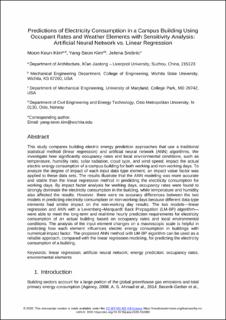| dc.contributor.author | Kim, Moon Keun | |
| dc.contributor.author | Kim, Yang-Seon | |
| dc.contributor.author | Srebric, Jelena | |
| dc.date.accessioned | 2021-08-31T11:52:09Z | |
| dc.date.available | 2021-08-31T11:52:09Z | |
| dc.date.created | 2021-02-25T13:00:11Z | |
| dc.date.issued | 2020 | |
| dc.identifier.citation | Sustainable Cities and Society (SCS). 2020, 62 . | en_US |
| dc.identifier.issn | 2210-6707 | |
| dc.identifier.uri | https://hdl.handle.net/11250/2771966 | |
| dc.description.abstract | This study compares building electric energy prediction approaches that use a traditional statistical method (linear regression) and artificial neural network (ANN) algorithms. We investigate how significantly occupancy rates and local environmental conditions, such as temperature, humidity ratio, solar radiation, cloud type, and wind speed, impact the actual electric energy consumption of a campus building for both working and non-working days. To analyze the degree of impact of each input data type element, an impact value factor was applied to these data sets. The results illustrate that the ANN modeling was more accurate and stable than the linear regression method in predicting the electricity consumption for working days. By impact factor analysis for working days, occupancy rates were found to strongly dominate the electricity consumption in the building, while temperature and humidity also affected the results. However, there were no accuracy differences between the two models in predicting electricity consumption on non-working days because different data type elements had similar impact on the non-working day results. The two models—linear regression and ANN with a Levenberg–Marquardt Back Propagation (LM-BP) algorithm—were able to meet the long-term and real-time hourly prediction requirements for electricity consumption of an actual building based on occupancy rates and local environmental conditions. The analysis of the input element changes on a macroscopic scale is helpful in predicting how each element influences electric energy consumption in buildings with numerical impact factor. The proposed ANN method with LM-BP algorithm can be used as a reliable approach, compared with the linear regression modeling, for predicting the electricity consumption of a building. | en_US |
| dc.language.iso | eng | en_US |
| dc.publisher | Elsevier | en_US |
| dc.rights | Attribution-NonCommercial-NoDerivatives 4.0 Internasjonal | * |
| dc.rights.uri | http://creativecommons.org/licenses/by-nc-nd/4.0/deed.no | * |
| dc.subject | Linear regression | en_US |
| dc.subject | Artificial neural networks | en_US |
| dc.subject | Energy prediction | en_US |
| dc.subject | Environmental elements | en_US |
| dc.subject | Occupancy rates | en_US |
| dc.title | Predictions of electricity consumption in a campus building using occupant rates and weather elements with sensitivity analysis: Artificial neural network vs. linear regression | en_US |
| dc.type | Peer reviewed | en_US |
| dc.type | Journal article | en_US |
| dc.description.version | acceptedVersion | en_US |
| cristin.ispublished | true | |
| cristin.fulltext | postprint | |
| cristin.qualitycode | 1 | |
| dc.identifier.doi | 10.1016/j.scs.2020.102385 | |
| dc.identifier.cristin | 1893683 | |
| dc.source.journal | Sustainable Cities and Society (SCS) | en_US |
| dc.source.volume | 62 | en_US |
| dc.source.issue | 102385 | en_US |
| dc.source.pagenumber | 12 | en_US |

